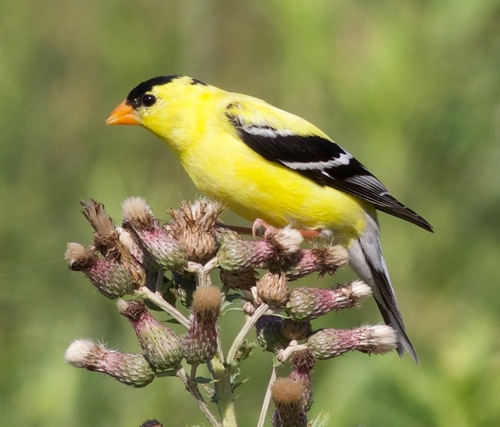
American Goldfinch
The American Goldfinch (Spinus tristis) is a vibrant, small songbird common throughout North America. Known for its bright yellow plumage during the breeding season, it's a welcome sight in gardens and fields. These birds play a crucial role in seed dispersal and are highly adapted to feeding on thistle and other seeds. Culturally, the American Goldfinch is the state bird of New Jersey, Iowa, and Washington, symbolizing a connection to nature and the beauty of the changing seasons.
11-14 cm
Length
19-22 cm
Wingspan
Least Concern
Conservation Status
Distribution
The American Goldfinch is found across North America. Breeding ranges extend from southern Canada to the southern United States. During winter, northern populations migrate south, reaching as far as Mexico. They are altitudinally flexible, occupying various elevations.
Lifespan
Typically 3-7 years in the wild, though some individuals may live longer.
American Goldfinch's Habitat
Habitat Types
Open woodlands, Fields, Meadows, Roadsides, Gardens, Orchards
Climate Zones
Temperate, Subtropical
Adaptations
American Goldfinches thrive in disturbed habitats with weedy plants. Their small size and agility allow them to cling to seed heads, and their conical beaks are specialized for extracting seeds.
Variations
Several subspecies exist, differing slightly in size and plumage coloration. These variations are generally subtle and related to geographic location.
Appearance
Breeding Plumage
Breeding males are bright yellow with a black forehead, black wings with white markings, and a white rump. Females are duller yellow-brown. Non-breeding males and females are drab olive-brown.
Seasonal Feather Changes
Significant seasonal changes occur, with males molting into their bright breeding plumage in late winter or early spring and back to a duller plumage in the fall.
Sex Based Plumage Differences
Pronounced during breeding season; males are brightly colored, while females are more camouflaged.
Notable Features
Conical beak, Black wings with white wing bars, Black forehead in breeding males
Diet and Feeding
Primary Foods
Seeds, Thistle seeds, Nyjer seeds, Sunflower seeds, Small insects (especially during breeding season)
Foraging Behavior
American Goldfinches are acrobatic feeders, often clinging to seed heads and extracting seeds with their beaks. They are also frequent visitors to bird feeders.
Specializations
Their conical beak is perfectly adapted for extracting seeds from composite flowers like thistles and sunflowers.
Seasonal Diet Variations
The diet is primarily seeds year-round, but insects become a more significant component during the breeding season to provide protein for growing chicks.
Behavior
Social Structure
American Goldfinches are highly social, often forming flocks, especially outside the breeding season. Breeding pairs are territorial.
Communication
High-pitched, twittering calls, A distinctive "po-ta-to-chip" flight call, Complex songs used in courtship and territorial defense
Migration
Northern populations are migratory, moving south for the winter. Southern populations may be resident or undertake shorter-distance movements.
Territorial or Group Behaviors
During the breeding season, pairs defend small territories around their nests. Outside of breeding, they form flocks, sometimes numbering dozens of birds.
Conservation
Threats
Habitat loss, Pesticide use
Protection Programs
Habitat restoration initiatives, Promotion of native plant gardening
Local National Laws
Protected under the Migratory Bird Treaty Act in the United States.
Population Trend
Stable
Population Estimates
Global population estimated to be in the tens of millions.
Interesting Facts
They are one of the latest-nesting songbirds in North America.
This is due to their reliance on thistle seeds, which become abundant later in the summer.
They use spider silk and plant down to build their nests.
This creates a soft, tightly woven cup that can hold the eggs securely.
Males molt their bright yellow plumage twice a year.
They have a complete molt after breeding and a partial molt before breeding.
Faqs about American Goldfinch
What should I feed American Goldfinches?
Offer Nyjer (thistle) seeds, sunflower seeds, and keep a clean birdbath available.
Why are they sometimes called 'wild canaries'?
This nickname refers to the bright yellow plumage of breeding males, which resembles that of a canary.
Do American Goldfinches migrate?
Yes, northern populations migrate south for the winter, while some southern populations are resident.
How can I attract American Goldfinches to my yard?
Plant native thistles, sunflowers, and other seed-bearing plants, and provide a source of fresh water.
Copyright @ Nature Style Limited. All Rights Reserved.
 English
English